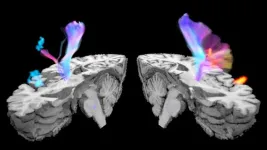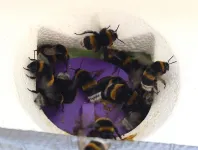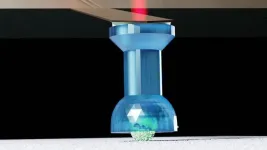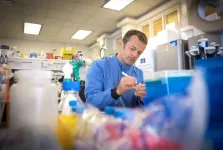(Press-News.org)
A new USC-led study using functional magnetic resonance imaging (fMRI) reveals the neural mechanisms that contribute to urinary incontinence, a common condition affecting stroke survivors that has a significant impact on their quality of life.
The research, just published in Stroke, was conducted by a multidisciplinary team of urologists, neurosurgeons, and imaging experts from the Keck School of Medicine of USC, Keck Medicine of USC, the Rancho Los Amigos National Rehabilitation Center, and the Shirley Ryan Ability Lab. The team discovered significant differences in brain activity during voluntary versus involuntary bladder contractions, presenting potential pathways for targeted therapies.
Urinary incontinence affects up to 79% of patients in the immediate aftermath and persists in nearly 40% of survivors one year later. It typically arises from uncontrolled bladder contractions and involuntary urine expulsion, leaving patients with debilitating symptoms such as urinary urgency, frequency, and leakage. Although common, it is often undertreated. This condition also predicts poorer long-term outcomes, including higher mortality rates and increased disability.
“The brain plays a crucial role in regulating the bladder, allowing people to sense bladder fullness and giving them the ability to delay urination until it is socially appropriate or initiate it at will,” said Evgeniy Kreydin, MD, adjunct assistant professor of clinical urology and lead author of the study. “In contrast, stroke survivors often struggle to suppress unwanted bladder contractions and may even lose bladder sensation and awareness entirely. Since a stroke impacts the brain, it disrupts the normal pathways that govern bladder control. Nevertheless, the precise neurological foundations of this dysfunction have remained poorly understood until recently.”
This research played a key role in Kreydin receiving the McGuire-Zimskind Award from the Society of Urodynamics, Female Pelvic Medicine, and Urogenital Reconstruction (SUFU). The award honors early-career professionals within ten years of completing residency or fellowship who have made significant contributions to the field through basic and clinical research. The study utilized an innovative method of repeated bladder filling and voiding while participants were inside the MRI, during which their brain function was measured.
"In contrast to previous studies where participants using a catheter entered the scanner with a full bladder and voided on command, our study enabled us to observe filling and voiding repeatedly. The simultaneous recording of bladder pressure allowed us to identify both voluntary and involuntary bladder emptying. This allowed us to detect differences in brain activity during involuntary emptying for the first time," said Kay Jann, PhD, of the USC Mark and Mary Stevens Neuroimaging and Informatics Institute at the Keck School of Medicine. Jann develops analytical tools and clinical translations of functional MRI technology and served as the imaging expert for the study.
During voluntary bladder emptying, when participants consciously decided when to empty the bladder, both healthy individuals and stroke survivors showed significant activation in brain regions associated with sensorimotor control and executive decision-making. In contrast, involuntary or incontinent bladder emptying in stroke survivors was marked by minimal cortical activation, suggesting a failure to engage key brain networks necessary for urinary control.
In both healthy individuals and stroke survivors, bladder filling before voluntary urination triggered activity in a collection of brain regions known as the salience network. These brain regions work together to evaluate the importance of internal or external stimuli and coordinate the brain's response to those stimuli. However, during bladder filling that preceded involuntary urination, this network remained inactive for stroke survivors with incontinence. These findings suggest the inability to engage the salience network may be a core mechanism underlying post-stroke urinary incontinence.
These findings open doors for novel interventions aimed at restoring bladder control in stroke patients. Potential therapeutic approaches could include:
Using non-invasive brain stimulation techniques, such as transcranial magnetic stimulation (TMS) or direct current stimulation (tDCS), to target the salience network
Developing medications that enhance neural activation in critical continence control regions
Cognitive training and biofeedback therapies designed to improve bladder awareness and voluntary control
While the study represents a significant advancement in understanding post-stroke incontinence, the researchers emphasize the need for further investigation. Future studies could explore how different types of strokes affect urinary control and whether early intervention targeting the salience network might help prevent chronic incontinence in stroke survivors.
Charles Liu, PhD, MD, director of the USC Neurorestoration Center, senior author of the study, and coordinator of all the collaborators, is hopeful for further discovery as this important research is built upon. "The neurological basis of urination is still poorly understood, and additional research will be crucial for the neurorestoration of the urinary and reproductive systems," said Liu, who is also a professor of clinical neurological surgery, surgery, psychiatry and the behavioral sciences, and biomedical engineering at the Keck School of Medicine. "This work not only deepens our understanding of a common post-stroke complication but also provides hope for a better quality of life for millions of stroke survivors globally."
This study was funded by a grant from the Urology Care Foundation to Evgeniy Kreydin. The authors include Evgeniy I. Kreydin, MD, Aidin Abedi, MD, Luis Morales, MD, Stefania Montero, MD, Priya Kohli, BS, Nhi Ha, BS, David Chapman, MD, Armita Abedi, MD, David Ginsberg, MD, Kay Jann, PhD, Richard L. Harvey, MD, and Charles Y. Liu, MD, PhD.
END
Using eye-tracking — a technique for recording and analysing eye movements — a team from the University of Geneva (UNIGE) has shown that individuals with multiple disabilities can improve their social and emotional skills. Although these patients are often considered ‘‘untestable’’, nine young people have undergone personalised training over a period of one year, with promising results in terms of their ability to socialise. This work opens the way to new methods of assessment and support. It is published in Acta Psychologica.
Multiple disabilities involve a combination of severe intellectual and motor impairments, resulting in profound dependence. ...
Since the pandemic, we are very aware of the power of social distancing to protect against infectious disease. But can social distancing be effective if the infectious agent isn’t a virus or bacterium, but an insect powered by a brain and wings, and with the instinct to seek out new hosts?
Now, a study published to Frontiers in Bee Science has shown that physical distance does play a leading role in protecting bumblebees against a flying insect parasite, the bumblebee wax moth Aphomia sociella. The source of the potentially lethal infection was another species, namely nearby hives of domestic honeybees.
“Here we show that infestation with bumblebee wax moths is much greater ...
Lacquers, paint, concrete—and even ketchup or orange juice: Suspensions are widespread in industry and everyday life. By a suspension, materials scientists mean a liquid in which tiny, insoluble solid particles are evenly distributed. If the concentration of particles in such a mixture is very high, phenomena can be observed that contradict our everyday understanding of a liquid. For example, these so-called non-Newtonian fluids suddenly become more viscous when a strong force acts upon them. For a brief moment, the liquid behaves like a solid.
This sudden thickening is caused by the particles present ...
Genome wide association studies (GWAS) have identified hundreds of genome regions containing thousands of genetic variants associated with asthma, but it’s still not clear which variants have an actual causal link to the disease. This “variant-to-function” gap is one of the biggest challenges to the usefulness of these genomic studies and has motivated researchers to develop new tools to make sense of GWAS results.
A new study by researchers from the University of Chicago combines genetic data and improved computational tools to look more closely ...
People should learn to meditate and hone their critical thinking skills as AI becomes more integrated into daily lives, an expert suggests.
Digital strategy expert Giulio Toscani has spoken with 150 AI experts across 50 countries to understand the challenges and opportunities around human interactions with artificial intelligence.
He argues in his new book, Augmented: prAIority to Enhance Human Judgment through Data and AI, that as humans operate largely unconsciously by design, they are inclined toward immediacy and instant rewards, often overlooking potential ...
The development of new antibiotics to treat superbugs and other bacterial infections is a global priority, with the rate of infections that cannot be treated with current antibiotics rising and presenting one of the biggest threats to human health.
In line with that, new research has shown a daily dose of epidermicin NI01 – an antibiotic compound developed by University of Plymouth spinout company Amprologix – is as effective at removing Methicillin-resistant Staphylococcus aureus (MRSA) as the current standard of care.
The results were achieved through a robust skin MRSA infection model, and those behind the research say it justifies ...
WASHINGTON (April 9, 2025) — A new study from researchers at the George Washington University has found that certain bacteria living in the nose may influence how likely someone is to get a COVID-19 infection. Published in EBioMedicine, the research reveals that certain types of nasal bacteria can affect the levels of key proteins the virus needs to enter human cells, offering new insight into why some people are more vulnerable to COVID-19 than others.
“We’ve known that the virus SARS-CoV-2 enters the body through the respiratory tract, with the nose being a key entry point. What’s new—and surprising—is that bacteria in our noses ...
A study led by the Barcelona Institute for Global Health (ISGlobal), a centre supported by the "la Caixa" Foundation, has shown that Europe has adapted better to low temperatures than to high temperatures over the last two decades. The research, carried out in collaboration with the Barcelona Supercomputing Centre (BSC) and published in The Lancet Planetary Health, shows that there has been a significant decrease in cold-related mortality risk in recent years compared to the first decade of the 2000s. There has also been a reduction in the risk of heat-related ...
In a cave overlooking the ocean on the southern coast of South Africa, archaeologists discovered thousands of stone tools, created by ancient humans roughly 20,000 years ago. By examining tiny details in the chipped edges of the blades and stones, archaeologists are able to tell how the tools were made. In a new study published in the Journal of Paleolithic Archaeology, researchers analyzed these stone tools and discussed how the different techniques used to make them hint at the ways that prehistoric people traveled, interacted, and shared their craft.
“This is an important insight into how people who lived in this region ...
10 April 2025: The world’s first baby has been born following conception with a fully automated, digitally controlled intracytoplasmic sperm injection (ICSI) system. ICSI, developed and adopted into widespread use in the 1990s and now a routine method of assisted conception, achieves fertilisation by injecting a single sperm cell into the centre of a mature egg.
The details are reported today in the peer-review medical journal Reproductive Biomedicine Online.(1) The automated system was described and developed by a multidisciplinary team of specialists from Conceivable ...





